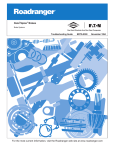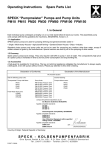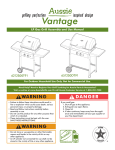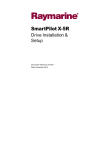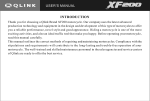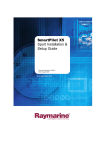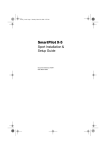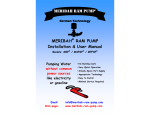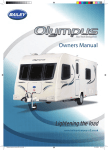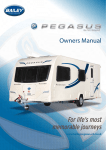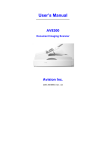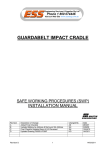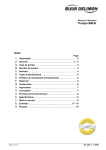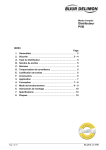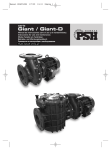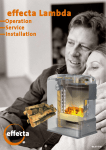Download Operating Instructions Spare Parts List SPECK “BÜFFEL” Pumps
Transcript
Operating Instructions Spare Parts List SPECK “BÜFFEL” Pumps and Pump Units BS15, BS25, BS40, BS50 1. In General Every individual pump undergoes a lengthy test-run before leaving our factory. The assembled pump units comply with the EC guidelines for machinery, 89/329/EEC, Annex II, A. 1.1 Application SPECK piston pumps are for pumping drinking-water and domestic water and find their use in: • Single & Multi-storey Houses • Agriculture/Farming • Shipping • Industry • Horticulture Standard piston pumps and pump units are not to be used for conveying any medium other than water, except if written consent is given by the manufacturer. Special versions are built by us for pumping other media. 1.2 Economy Speck piston pumps save energy. They only require 0.25 kW/h to pump 1 m3 of water. The comparatively high price of a piston pump is rewarded in time by its low power consumption and long working life. 1.3 Accessories A belt-guard is available for V-belt drive. The law on technical appliances obligates the manufacturer to always supply a belt-guard, even for pumps without motors. Please note this when ordering. Declaration of Conformity Declaration by the Manufacturer We herewith declare on our own liability that the following pump units Pumps with Motor: that the following Pump units BS15 BS25 BS40 BS50 BS15/150L BS15/200L BS15/300L BS25/200L BS25/300L Pumps without Motor: BS15 BS25 BS40 BS50 Pressure Tank Pressure Tank Pressure Tank Pressure Tank Pressure Tank comply with pertinent stipulations as per: EC-Machine Guidelines 98/37/EG Applied compatible standards: EN 809 EN 292 T1 EN 292 T2 Electromagnetic Compatibility: 89/336/EWG Applied compatible standards: EN50 081-1 EN50 082-2 Use of Electrical Equipment within specified Voltage Limits: 73/23/EWG Applied compatible standards: EN60 335-1 EN60 335-2-51 ppa. ........................................ (Technical Director) Country of Origin: Federal Republic of Germany S P E C K - K O L B E N P U M P E N FA B R I K Otto Speck GmbH & Co. KG · P.O.Box 1240 · D-82523 Geretsried Tel. (08171) 62930 · Telefax (08171) 629399 D1620 0 1108L 1 1.4 Technical Data and Dimensions “Büffel” Piston Pump Model Flow Rate Water Head normal/maximum Motor Performance at 40m Motor Performance at 60m No. of V-Belts Profile x Inner Length Connection Sizes Suction x Discharge Dimensions approx. Weight w/o Motor approx. BS15 BS25 BS40 BS50 l/h 1500 2500 4000 5000 m 40/60 40/60 40/60 40/60 kW 0,37 0,55 0,75 1,1 kW 0,55 0,75 1,1 1,5 2 10x820 2 13x975 2 13x1120 2 17x1335 Inch 1x1 1¼x1 1½x1¼ 2x1½ cm kg 52x22x32 28 66x23x38 46 75x26x42 66 85x36x47 90 “Büffelpump” Pump Units - Pump with Horizontal Tank Pump Model Size of Tank Connection Sizes Suct./Disch. Flow Rate (litre) (inch) (l/h) 4 bar 6 bar 1500 0,37 0,55 150 BS15 200 300 BS25 200 300 1x1 1¼x1 1¼x1 Motor Performance (kW) 2500 0,55 “Büffel“ Pump Unit 2 0,75 Dimensions (L x B x H) Weight (approx. cm) (approx. kg) 105 x 45 x 84 75 107 x 50 x 85 87 140 x 55 x 96 93 107 x 50x 100 105 140 x 55 x 110 110 1.5 Spare Parts Section 1.51 Spare Parts List Part No. Description BS15 BS25 BS40 BS50 Part No. 1 Crankcase 01.0020 01.0148 01.0149 01.0142 18 Pump V-belt Pulley 1a Hexagon Screw 21.0290 21.0256 21.0125 21.0258 18a Hexagon Screw w/Pointed Extension 21.0161 1b Stud Bolt 21.0147 21.0045 21.0154 18b Motor V-Belt Pulley 19.0051 1c Hexagon Nut 07.3001 07.2398 07.0988 18c Pointed Threaded Stud 2 Gear Cover 03.0012 03.0025 19 Motor Mounting Rail left 2a Hexagon Screw 21.0256 21.0257 192 2x Gasket for Gear Cover 06.0440 06.0441 19a 2b Vent Plug 07.0614 2xx Gasket for 2b 06.0312 3 03.0026 03.0027 21.0258 06.0442 06.0443 Description BS15 BS25 BS40 BS50 19.0001 19.0014 19.0008 19.0049 19.0038 21.0113 19.0009 21.0114 23.0001 23.0018 23.0016 Motor Mounting Rail right 23.0119 23.0018 23.0120 Hinge Pin with Thread 11.0332 11.0331 11.0334 19b Hinge Pin 11.0235 11.0082 11.0335 19c Hexagon Screw 21.0116 21.0115 21.0120 Insulation Sleeve 07.0161 07.0162 07.2398 Valve Casing Assy w/Stud Bolts + Nuts 00.2384 00.2385 00.2386 00.2387 19d 3a Suction Flange 20.0031 20.0069 20.0062 20.0087 19e Hexagon Nut 07.3001 3b Discharge Flange 20.0031 20.0032 20.0088 191 Hexagon Screw 21.0290 3c Hexagon Screw 21.0062 21.0188 21.0253 Motor Rocker Assy 00.2442 3x Flange Gasket 06.0387 06.0400 06.0413 20/21 400 21.0110 19.0050 21.0256 00.2035 Diaphragm Safety Valve Assy w/Seat 4 bar 00.1303 Diaphragm Safety Valve Assy w/ Seat 6 bar 00.1304 Gear Assy 00.2012 00.2013 00.2014 00.2015 20/21 Air Chamber w/Safety Valve 4 bar + Filler Plug 00.2396 00.2397 00.2400 00.2401 20x Gasket for Safety Valve Casing 00.2443 00.2444 00.1305 00.1306 06.0647 Air Chamber w/Safety Valve 6 bar + Filler Plug 00.2425 00.2426 00.2428 00.2429 21 Safety Valve Seat Assy 00.3205 5 Air Chamber w/o Safety Valve 01.0341 01.0232 01.0235 01.0237 21x Gasket for No 21 06.0312 00.3208 5x Air Chamber Gasket 06.0085 06.0086 06.0088 06.0089 22 Acorn Nut for Air Chamber 07.0485 07.1257 01.0021 01.0233 01.0066 01.0534 22a Air Chamber Stud Bolt 21.0044 21.0195 22b Disc 07.1259 07.1211 06.1020 07.0485 6 Stuffing Box Casing 6a Stuffing Box Screw 6b Seal Ring 6c Stuffing Box Insert 6d Gland Packing-Ring 06.1089 6f Brass Disc 07.1286 6x Stuffing Box Gasket 06.0508 06.0509 06.0510 06.0220 24x Gasket Stuffing Box complete 00.2255 00.2256 00.2257 00.2258 25 Main Bearing Sleeve 05.0032 05.0033 05.0039 05.0034 Piston Rod Assy with Hexagon Nuts 00.2391 00.5414 00.2393 00.2394 26 Oil Splash Cap 03.0100 03.0118 03.0098 03.0167 7 Piston Rod 11.0232 11.0233 11.0029 11.0234 27 Oil Scraper 06.0408 06.0417 06.0470 7a Hexagon Nut 07.0988 07.1738 28 Oil Filler Plug w/o Thread 07.0489 07.1319 07.1320 29 Snifting Valve G3/8 with Stop Screw 07.2875 07.1291 06.0403 - - 07.2398 23 Crosshead 17.0014 17.0015 17.0017 17.0002 07.2226 23a Crosshead Pin 11.0357 11.0358 11.0359 11.0360 06.1136 06.1139 24 Oil Indicator with Nut - 00.1953 - - 07.1293 07.2227 00.1959 - DUO-Piston Simrit Hexagon Nut 9 Cylinder Assy 00.1916 9a Hexagon Screw 21.0256 9x Cylinder Gasket 06.0777 06.0117 06.0525 10 Cylinder Cover 03.0014 03.0040 03.0144 03.0145 10a Hexagon Screw 21.0366 21.0256 10x Gasket for Cylinder Cover 06.0589 06.0590 06.0591 11 Suction Valve Assy 00.2170 00.2071 00.1291 111 Suction Valve Stem 112 Suction Valve Seat (Brass) 118 Self-Locking Hexagon Nut 12 Discharge Valve Assy Discharge Valve Stem 122 Discharge Valve Seat (Brass) 06.0872 06.0419 07.1292 8 07.4083 00.1917 06.0871 06.0877 07.4084 07.1944 00.1918 00.1919 21.0257 07.0023 00.2072 07.0020 06.0312 00.1939 00.1940 29a Snifting Valve Lip 06.0398 21.0258 29x Gasket for Snifting Valve 06.0118 30 Bearing Cover open 03.0185 03.0184 03.0028 30a Bearing Cover closed 03.0013 03.0194 03.0182 30b Hexagon Screw 06.0119 30x Gasket for Bearing Cover 06.0447 00.2269 301 Radial Shaft Seal 06.0418 302 Grooved Ball Bearing 05.0111 06.1020 21.0315 07.1945 303 Spacer Ring 07.1302 - - 304 Spacer Ring 07.1302 00.2270 304a Woodruff Key 00.1292 07.1219 07.0022 - 07.0065 07.2540 00.1938 Snifting Valve G3/8 with Hose Nipple 07.1220 07.0669 00.2171 Oil Level Gauge/Oil Dipstick 21.0366 07.2539 07.0021 21.0043 07.1259 06.0411 8a 121 06.0873 21.0042 21.0125 06.0448 06.0449 06.0399 05.0151 06.0409 05.0110 07.1307 07.1307 05.0156 07.1321 07.1450 07.1540 07.1200 33 Plug 07.0751 07.2803 07.2608 07.1946 33x Gasket 06.0312 - - 34 V-Belt 07.1303 07.1308 07.1312 07.1322 06.0857 06.0858 35 Main Bearing Shaft 11.0018 11.0019 11.0013 11.0014 03.0188 03.0189 - - 07.1977 06.0746 06.0747 06.0436 07.2538 06.1020 119/129 Suction and Discharge Valve Retainer 113/123 Suction / Discharge Rubber Valve Plate 114/124 Spring Tension Disc (large) - - 07.1939 07.1361 35a Cover for Main Bearing Shaft 115/125 Valve Spring - - 07.3662 07.0025 35b Notched Nail 116/126 Spring Tension Disc (small) - - 35x Gasket for Main Bearing Shaft 117/127 Cotter Pin - - 405 Fitting Disc for Connecting Rod 0.5mm 07.1304 07.1313 11x/12x Gasket for Valve Seat 06.0391 06.0405 06.0416 06.0518 405a Fitting Disc for Cnnecting Rod 0.2mm 07.1305 07.1314 07.1924 13 Valve Bridge Stud Bolt 21.0002 21.0194 21.0046 21.0051 xx 00.2455 00.2456 13a Hexagon Nut 07.3001 13b Disc 07.2904 14 Valve Brigde 15 Plug 07.0487 15x Gasket 06.0054 06.1065 06.1066 07.1360 07.1215 07.2398 - 03.0268 07.0988 - - 03.0042 03.0044 Complete Set of Gaskets 00.2453 00.2454 03.0190 Crankcase Assy 00.2753 00.2754 00.2755 00.2756 Crankcase Assy, exchanged 00.2757 00.2758 00.2759 00.2760 Pump Head Assy with Safety Valve 4bar 00.2617 00.2618 00.2619 00.2620 Pump Head Assy with Safety Valve 6bar 00.2745 00.2746 00.2747 00.2748 16 Plug 07.0487 Air Volume Control 00.2479 16x Gasket 06.0054 Air Hose 0.9 m 32.0006 17 Connecting Rod Assy 17a Tension Screw for Connecting Rod 17b Sleeve for Connecting Rod 17c Hexagon Nut 00.2004 00.2005 21.0103 05.0066 05.0067 07.2618 00.2006 00.2007 Drain Cock G3/8 00.1940 21.0104 21.0105 Gasket for Drain Cock 06.1020 05.0068 05.0069 07.2022 07.1995 3 07.1925 1.5.2 Exploded View N.B. The self-locking nut in the suction valve should only be used once.Please keep this in mind when ordering spare parts! Valves BS15 / BS25 When ordering spare parts, please state item number and code number of the part required as well as the pump model and year of construction which can be found on the name plate. 4 2. Safety This Operation Manual gives basic instructions which are to be observed during installation, operation and maintenance of the pump. It is therefore imperative that this manual be read by the responsible personnel/operator prior to assembly and commissioning. It is always to be kept available at the installation site. It is not only the general safety instructions contained under this main heading `Safety` that are to be observed, but also the specific information provided under the other main headings. 2.1 Kennzeichnung von Hinweisen in der Betriebsanleitung Safety instructions given in this manual, non-compliance with which would affect safety, are identified by the following symbol: or where electrical safety is involved, with see DIN 4844 - W9 see DIN 4844 - W8 Safety measures which can cause damage to the machine if not adhered to, are marked It is imperative that signs affixed to the machine, e.g. • arrow indicating the direction of rotation • symbols indicating fluid connections be observed and kept legible. 2.2 Qualification and Training of Operating Personnel The personnel responsible for operation, maintenance, inspection and assembly must be adequately qualified. Scope of responsibility and supervision of the personnel must be exactly defined by the plant operator. If the staff does not have the necessary knowledge, they must be trained and instructed, which may be performed by the machine manufacturer or supplier on behalf of the plant operator. Moreover, the plant operator is to make sure that the contents of the operating manual are fully understood by the personnel. 2.3 Hazards in the Event of Non-Compliance with the Safety Instructions. Non-compliance with the safety instructions may produce a risk to the personnel as well as to the environment and the machine, and may result in a loss of any right to claim damages. For example, non-compliance may involve the following hazards: • Failure of important functions of the machine/plant • Failure of specified procedures of maintenance and repair • Exposure of people to electrical, mechanical and chemical hazards • Endangering the environment owing to hazardous substances being released. 2.4 Safety at Work The safety instructions contained in this manual, the relevant national accident prevention regulations and any other service and safety instructions issued by the plant operator are to be observed. 2.5 Safety Instructions Relevant for Operation • If hot or cold machine components involve hazards, they must be guarded against accidental contact. • Guards for moving parts (e.g. coupling) must not be removed from the machine while in operation. • Any leakage of hazardous (e.g. explosive, toxic, hot) fluids (e.g. from the shaft seal) must be drained away so as to prevent any risk to persons or the environment. Statutory regulations are to be complied with. • Hazards resulting from electricity are to be prevented (see, for example, the VDE Specifications and the by-laws of the local power supply utilities). 2.6 Safety Instructions Relevant for Maintenance, Inspection and Assembly Work It shall be the plant operator’s responsibility to ensure that all maintenance, inspection and assembly work is performed by authorized and qualified personnel who have adequately familiarized themselves with the subject matter by studying this manual in detail. Any work on the machine shall only be performed when it is at a standstill. Pumps and pump units which convey hazardous media must be decontaminated. On completion of work, all safety and protective facilities must be re-installed and made operative again. Prior to restarting the machine, the instructions listed under `Operation` are to be observed. 5 2.7 Unauthorized Alterations and Production of Spare Parts Any modification to the machine may only be made after consultation with the manufacturer. Using spare parts and accessories authorized by the manufacturer is in the interest of safety. Use of other parts may exempt the manufacturer from any liability. 2.8 Unauthorized Modes of Operation The reliability of the machine delivered will be only guaranteed if it is used in the manner intended, in accordance with clause 1 `In General` of this manual. The limit values specified in the data sheet must under no circumstances be exceeded. Pending Standards and other Data DIN4844 Part 1: Safety descriptions and safety signs W8 supplement sheet 13 DIN4844 Part 1: Safety descriptions and safety signs W9 supplement sheet 14 3. Transport and Storage Pumps and pump units must not be stored for any length of time in a humid place or where temperatures are below zero.The storage room should be airy as moisture will damage the motor and thus void the warranty. Pumps are packed for transportation in cardboard boxes or on pallets. When unpacking, check for damage. 4. Description 4.1 “Pumpmeister” SPECK piston pumps of the ‘’Büffel’’ pump series have a thoroughly proven double-helical precision gear of unsurpassed working quietness and service life. When turned in the correct direction, the gear is lubricated by an oil-dip bath with flooded crosshead. Suction and discharge connections are on the valve casing and are interchangeable. Valve casing, air chamber, stuffing box and cylinder cover are of grey cast iron (GG20). The brass suction and discharge valves (2 of each) are made easily accessible by removing the air chamber. The suction/discharge line does not have to be removed. The solid conrod is of bronze (G-CuSn10). The brass cylinder sleeve can be removed using set-screws. The duo-piston is of NBR rubber. Teflon-impregnated packing rings are used for the piston rod sealing in the stuffing box. A built-in diaphragm safety valve protects against excess pressure. Water will not flow out of the pump if the pressure is too high. Surplus water is circulated within the pump, back to the suction side. 4.2 “Büffelpumpe” Pump Unit SPECK pump units are ‘’Büffelpumpe’’ piston pumps on galvanized horizontal pressure tanks, complete systems ready for connection. They are equipped with an electric motor, V-belt pulleys, V-belts, belt-guard, automatic air volume control, pressure switch, pressure gauge and a built-in safety valve. The automatic air volume control installed in the pressure tank of the unit automatically ensures the correct ratio between water content and the necessary air cushion. If the horizontal tank is half full, the valve of the automatic air volume control, activated by the float, opens and the pump begins conveying both air and water into the tank. A suction head of approx. 4-6 m is required so that the pump can draw in air in the proper manner. When water leaves the tank, the pressure in the tank drops until the pressure eventually sinks to the automatic switchon point at which the pressure switch turns on the motor/pump. The amount of water which left the tank is then pumped in again until the switch-off level is attained. This procedure repeats itself again and again at irregular intervals, depending on how often and how much water is withdrawn from the tank. 4.3 Values for Pressure Switch Adjustment Pump Unit 4 bar: Switch-On Pressure: Switch-Off Pressure: 2 bar 3.5 bar Pump Unit 6 bar Switch-On Pressure: Switch-Off Pressure: 3 bar 5.5 bar 6 5. Set-Up and Installation (only to be done by skilled workmen) 5.1 Pump Unit The complete pump unit with horizontal pressure tank is supplied ready-assembled. A special foundation is not necessary. The tank can be fixed to the foundation by 4 spacer blocks. The room must be frost-proof and dry. It should also be well aired in order to prevent undesirable moisture condensate forming on the unit. Moisture damages the motor. If there is a danger of frost, the drainage plugs (15) are to be removed. The piston chamber must then be emptied by closing off the suction line and running the pump for approx. 30 sec. To protect against accidents, each pump is to be equipped with a belt-guard which conforms to trade union and/or general safety rules. The pump-motor must be protected by a correctly adjusted motor protector. „Büffel“ Pump Unit: Pump and motor, horizontal pressure tank and belt-guard 5.2 Pump Unit with Vertical Tank Assembly: In contrast to the pump units with horizontal tanks which are supplied ready assembled, the units with vertical tanks have to be set up and installed by a plumber on location. They function the same as the ready assembled units. However, we wish to point out that an automatic air volume control can also be installed in a vertical tank when the unit is being set up (s. fig. 113). Directions (D10671) for installing the automatic air volume control are available upon request. Discharge Line Suction Line Fig. 113 „Büffel“ pump 7 unit with vertical tank 5.3 „Büffel“ Pump Single ‘’Büffel’’ piston pumps are screwed on to a brick or concrete base and secured with foundation bolts. No particular foundation is required for vertical tanks. Pumps without a base plate and therefore without vibration insulation should be mounted on to a piece of anti-vibration material placed between the pump and ground. Fig. 112 „Büffel“ pump 5.4 Suction Line for Pump Units and ‘’Büffel’’ Pumps Perfect functioning of the pump depends largely on well layed-out suction lines. In order to prevent airpockets, the suction line should rise gradually from the well to the pump, or should at least be layed horizontally. It must be absolutely seal proof and the inner diameter should at least be as large as the connection on the pump. Only bows are to be used, no elbows. It is advisable to install a foot valve or an intermediate valve in the case of a closed filter well. If suction lines are longer than 30 m, a suction air chamber is to be installed directly in front of the pump. If vertical tanks are used (fig. 113), it is advisable to support heavy suction lines so that their weight does not pull on the pump. 5.5 Suction Head The total gauged suction head which is the height between the water level and the pump plus loss of friction in the pipe and possible filter resistance, is not to exceed 7.5 m, not forgetting that in dry seasons the water level in the well may be lower than usual. In the case of short suction lines or a suction head of below 2m, or if input pressure is present, a shut-off valve (not a tilted seat-valve) must be installed in front of the pump. This shut-off valve can be adjusted with greater accuracy to the required suction head, ensuring the avoidance of water-hammer. 5.6 Intake Pressure - Pump Unit as Booster Set If the inlet pressure is more than 0.3 bar (3 m), it is advisable to install a pressure-free tank with float valve. If this cannot be done, a shut-off regulator valve must under all circumstances be installed in the feed line. A vacuum of 4-6 m has to be provided if the automatic air volume control is to function properly. If the pump hammers, install a suction air chamber (approx. 7.5-15 ltrs) in the feed line. A shut-off valve is at all events necessary in a suction line with intake pressure so the pump can be opened for servicing. 5.7 Discharge Line - Refers only to installation of pump units with vertical tanks or pumps alone If possible, the line should rise gradually upwards from the pump to the tank or at least be horizontal - it should never slope downwards. Only use curved joints, elbows may only be used after the tank. 5.8 Umtausch der Saug- und Druckanschlüsse (Does not apply to units with horizontal tanks) The suction and discharge sides of SPECK ‘’Büffel’’ pumps can be interchanged by converting the suction and discharge valves. This often saves inconvenient installation of suction and discharge lines. Install clean valve seals and make sure the valves sit properly. Starting torque of holding screw: BS15: 12Nm (M8) BS25: 16Nm (M10) BS40: 18Nm (M10) BS50: 36Nm (M12) After suction and discharge valves have been exchnged, the air chamber must be turned around 180° so that the safety valve is always located on the discharge side. ( see figure 115) Fig. 114 8 6. Operation 6.1 To Fill Pump with Oil Fill crankcase with an SAE30 quality oil through opening above crosshead (23). BS15 BS25 BS40 BS50 0,2 litres 0,3 litres 0,8 litres 1,0 litres 6.2 To Fill Pump with Water Fill up pump head with water by pouring the water in via filler plug (33) At the same time, turn the pump V-belt pulley (18) manually in the direction of the arrow. In the case of long suction lines, fill right up to the foot valve/intermediate valve (see 5.4) 6.3 Motor Alignment and Electrical Connection Using a ruler, make sure the pump pulley and motor V-belt pulley (18/18b) are in line with each other. The motor could have been shifted during transport and if the pulleys do not align precisely, the belts will wear out quickly. Electric motors must be connected as per circuit diagram which can be found in the terminal box of the electric motor. This work is to be carried out by suitably qualified persons. 6.4 Fittings Open shut-off fittings and taps in the discharge line so that the air in the pipe system can escape. 6.5 To Switch on Motor Check the direction of rotation. Reverse polarity if the motor is running in the wrong direction. Close the shut-off fitting only after water has begun being pumped, after the suction line and pump are vented (clearly visible through transparent tube – fig. 111/II) and after water has come out of the tap. Depending on the size of the tank, it takes between 5-15 minutes until the tank is full and the pressure switch switches off at either 3.5 bar or 5.5 bar. 6.6 To Let Water Out Turn tap on and let water out. Pressure drops eventually to 2 or 3 bar respectively and the pump switches on again automatically. Only a few air bubbles should now be visible in the suction line, otherwise there is reason to believe that the suction is not correctly sealed. Approximately 2000 litres of water per hour flow out of an open G1/2 tap at 3 bar pressure. 6.7 On/Off Switching Pressure (for 4 and 6 bar units) The pump unit has a diaphragm safety valve which is adjusted to an activation pressure of either 4 or 6 bar. The pressure tank is also approved for max. pressure of 4 or 6 bar. The pressure switch must therefore be adjusted to a maximum pressure of 3.5 bar / 5.5 bar otherwise it will activate the safety valve. To readjust switch-on / switch-off pressure, see instructions on pressure-switch (Fig. 111/IV). Switching Stages: 4 bar Pump Unit 6 bar Pump Unit Switch-On Pressure Switch-Off Pressure Switch-On Pressure Switch-Off Pressure 2 bar 3,5 bar 3 bar 5,5 bar Suction Line Discharge Line Fig. 111 Büffel Pump Unit 9 7. Maintenance and Servicing 7.1 Lubrication The gear is lubricated automatically provided the pump revolves in the correct direction. Oil level should be checked every three months and topped up if necessary till oil can be seen through the indicator glass (24). First oil change after 3 months operation and then every 2 years, or every 6 months if the pump is running continuously. This is done by unscrewing the indicator (24) or screw (16) and draining out the old oil. Clean out the crankcase thereafter (removing gear cover [2]) and refill with fresh oil as described under paragraph 6.1. 7.2 Stuffing Box The compact stuffing box is made up of Teflon-impregnated packing rings and a seal ring and requires practically no maintenance at all. The stuffing box must not run dry. Single isolated drops serve to lubricate and cool it. Should the stuffing box continuously drip, tighten stuffing box nut (6a) carefully by approx. one 1/2 turn. If this does not help, the whole stuffing box (6d) must be replaced. In this case, the seal ring (6b) should also be changed. Pay careful attention when installing seal ring: the lip ring spring must face the piston. 7.3 V-Belts V-belt (34) should not be overtensioned. However, it is advisable to tighten belts up again after a few days of operation. When renewing V-belts on multi-belt drive, the complete set has to be replaced. 7.4 Gear The original SPECK high pressure ‘’Büffel’’ pump has a double-herringbone (helical) precision gear with a bronze connecting rod. If the directions under paragraph 7.1 for lubrication are followed, further maintenance is practically unnecessary. Only the connecting rod alone might need readjusting after approx. 1 year when it has been run in and if a possible knocking sound can be heard. To do this, unscrew self-locking hexagon nut (17c), screw out inner hexagon tension screw and remove 0.1 - 0.5 mm of spacer shims (405) as required from connecting rod joint. Screw back tension screw (17a) tightly against hexagon nut. After approx. 1 hour of operation, check whether the connecting rod has not been overadjusted and is running hot. Abb. 115 Crosssectional Diagramm of Casing 7.5 Air Replenishment - for Cold Water Operation Only The pump will run smoothly and silently if there is air in the air chamber. This air cushion is regulated via the snifting valve. At the same time air is pumped into the pressure tank. The more air there is in the pressure tank, the more water can be discharged before the pump switches on again (see paragraph 4.2). If the automatic air volume control has to be repaired, kindly ask for our instruction sheet D10672. The unit itself is only available as a complete set. 10 8. Failures and Remedies If you have trouble with your pump, you may be able to help yourself by reading the tips we give you below. If you cannot find the reason for the trouble, call a plumber or write to us, not forgetting to mention the pump model and its serial number. Prior to doing any work on the pump, switch off the electricity and make sure that the pump is idle and the pressure at zero. 8.1 Little or no water at all is being pumped Possible Reason Remedy a) Pump is running but delivers no water even though it is filled properly. Remove air chamber (5) and loosen rubber valve discs (113/123) which have probably got stuck if the pump has been stored for a long time. b) Not sufficient water in the pump. Refill pump as explained in 6.2 and at the same time turn the pump several times pouring in water little by little till there are 2-4 litres in the pump. Screw on filler plug (33) again and seal carefully. More water may be necessary if the suction line is very long or the suction head very high. c) Suction head too high / suction line too long. Measure difference between water level and pump flange connection (fig. 111/I). Compare loss of friction in long pipes with table (available upon request) and add the difference in height. d) Suction line is not seal-proof. After the pump has been running for a while, check whether air bubbles can be seen through transparent hose (Fig. 111/II) above elbow on tank. If so, press out air, find leak and make it seal-proof. e) Soiled or worn-out valves Pebbles, hemp, shavings etc. coming from new wells often get absorbed into the pump so the air chamber (5) has to be removed and the valves checked. Loosen nuts above valve bridge. Remove valve bridge and any crust which may be on it. Valves are not screwed in. If they are stuck, press them loose with the handle of a hammer. The valve seat seal is under the valve - make sure that the seat is clean. Rubber valve discs (113/123) may have to be replaced if the pump is old. f) Stuffing box is not seal-proof. Tighten up nut (6a) a little. If this does not help, replace packing rings (6d) and possibly seal rings (6b) as well. Do not use hemp, we use Teflon-impregnated packing rings. 8.2 Pump Knocks Possible Reason Remedy a) There is no air cushion in the air chamber Make sure that the air volume control (Fig.111/III) is working properly. The snifting valve should hiss when the pump is running. Check whether rubber lip (29a) is dirty or clogged. Air could be escaping through screw on filler plug, therefore check by covering sealing surfaces of air chamber and filler plug with a soap solution. b) Pre-pressure in pump Water level in pump/air chamber is too high because snifting valve has not absorbed enough air. Install regulator in suction line (s.5.5/5.6). Pump should run with about 5 metre vacuum ensuring that sufficient air is pumped. c) Pump suction head is very low Same applies here as explained under b). A vacuum must be provided by means of a regulator so that sufficient air will be pumped. d) High suction head - long suction line Install a suction air chamber as per 5.4 and ensure sufficient ventilation. Make sure there is enough water in the well, e.g. after a dry season. e) Conrod bearings in pump deflect You can not always determine the reason for knocking by ear, so you have to turn the Vbelt pulley (18) backwards and forwards to determine any clearance between bearing and conrod. Repairs to the gear are best done by a skilled tradesman. f) The pump V-belt pulley deflects and does not sit properly on the crankshaft As described under e). g) One of the ball bearings is defective As described under e). 8.3 Pump switches on when very little water is discharged and switches off immediately the tap is turned off Possible Reason Remedy The air cushion is not filled up sufficiently. During initial operation, there may not have been enough air pumped into the tank or the air the pump has pumped into the tank is escaping somewhere (pressure switch, pressure gauge, air volume control, pump connections, transport damage). If snifting valve and air volume control are working properly (111/III) and there still is not enough air in the tank, coat all threaded connections on tank with a soap solution to determine where it is leaking. It could also be that the pressure switch (111/IV) is not airtight. 11 8.4 Pump switches on automatically although taps are turned off Possible Reason Remedy a) A tap is leaking or air is escaping from the tank. Check by switching off the complete unit overnight. Turn off all taps and check whether the pressure drops. b) Leaky valves or leaky safety valve cause water to run back into the well. Open pump and check whether the valves are sealing properly. c) Foot valve/intermediate valve in the suction line leaks. Water runs back into the well. Switch pump off and lift safety valve at 3.5/5.5 bar. If foot valve/intermediate valve is working properly, no return flow should be heard (or seen at pressure gauge of tank) immediately after lever (214) has been lifted. 8.5 Air escapes from tap when water is let out Possible Reason Remedy a) There is too much air in the tank. The well water is probably very gassy and a lot of air separates into the tank. If the suction line is very long and the suction head high, it could be that too much air is being pumped. In this case, it is advisable to disconnect the pipe of the air volume control for a while or install a special rubber lip with a very small hole into the snifting valve. b) Suction line leaks. Find leak and seal it. 8.6 Water is pumped easily till shortly before switch-off pressure is reached and then the pump continues to run but does not pump any water because it can’t reach the final pressure Possible Reason Remedy This can happen if too much air is pumped through the air volume control when suction lines are very long and suction head very high. This often occurs when the suction line is not absolutely seal-proof and allows even more air to get into the pump. It can also be caused by worn out rubber valve plates, worn out cylinder or pistons. We recommend either installing a rubber lip with a very small hole or put the air volume control in the suction line out of action from time to time. Replace rubber valve plates (113/123). Check whether piston or brass cylinder are worn out and replace as necessary. 8.7 Water leaks at Air Volume Control Possible Reason Remedy Rubber lip of snifting valve (29) is damaged. Replace rubber lip (29a). Suction Line Discharge Line Fig. 111 „Büffel“ Pump Unit 12












